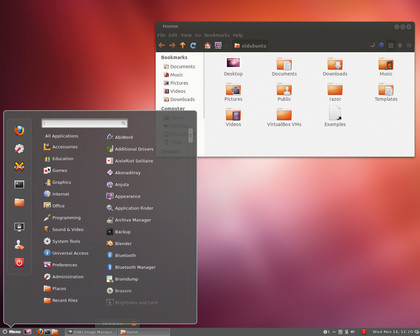Best alternative Linux desktops: 5 reviewed and rated
See how good your Linux desktop could be
In contrast, Mate, Cinnamon and Xfce do their best to provide sensible defaults that will work well for most people. There isn't such a heavy emphasis on making your own tweaks, but that's not to say that there's nothing you can do to adapt your working environment.
In Cinnamon, there's the System Tools > System Settings menu, which controls things such as themes, workspace behaviour and desktop effects, but these don't go as far as Trinity's config options.
Razor-qt is the other KDE-influenced desktop in this Roundup, and although it doesn't have much in the way of applications, the icon for its configuration tool is displayed prominently on the toolbar next to the main menu workspace switchers and Firefox button.
As with KDE, you get a fine degree of control over where different desktop areas go and how much space they take up: just right-click and choose Unlock Desktop to move widgets around, then choose Lock Desktop when you're done. As it is, there isn't much point in rearranging the desktop's appearance, but the ability to customise from the ground up bodes well for the future.
Options in Xfce and Mate are more limited, but that's not what they're about: sensible defaults are the order of the day.
Verdict
Trinity: 5/5
Raqzor-qt: 4/5
Xfce: 3/5
Cinnamon: 2/5
Mate: 2/5
Both Trinity and Razor-qt put tweaking at the heart of the user experience.
Installation
Features are no good if we can't get it running
Whatever your system, Xfce has been around for so long that there's bound to be a package available for your distribution. The other projects don't have the benefit of that longevity, so are understandably a little trickier to install.
Razor-qt, for instance, saw its first release in 2010, and thus far it has only made it into the default repository of Mageia. All other users will have to add a repository to their package manager, perform a system update and then install from the command line. It's a similar process with Cinnamon, which has been around only since the beginning of 2012.
Adding a repository and installing Mint from the command line is a straightforward task in Ubuntu Fedora and OpenSUSE, but OpenSUSE also gives you the option of a one-click installation (actually it's more like four clicks and a password, but it's still impressively smooth and quick). The last time we looked at Cinnamon, in a review of Cinnamon 1.2 in LXF157, the user was required to manually extract files into specific directories. Well done to the Mint team for your progress in this area!
Likewise, Mate requires that you add a repository, update and then install the matedesktop- environment metapackage, which brings in the latest versions of all the components.
Trinity, in contrast, caused us more problems. It has been almost five years since KDE 4 was released, which means it's almost five years since the first person tried it and wished that they could go back to KDE 3. Packages are available for Debian, Fedora, Ubuntu, Mandriva, Mageia and Slackware, putting it second only to Xfce in terms of distributions supported.
But once we'd gone through the installation procedure on Ubuntu 10.04 Long Term Support (we had to downgrade our installation, as Ubuntu 12.10 is not yet supported) and chosen a display manager, we were given a terse error message "kdeinit not working: check your installation" and dumped into a non-functioning desktop. In the end, we resorted to a live CD version, which is supremely easy, but inconvenient if you're not a fan of Fedora.
Verdict
Xfce: 5/5
Razor-qt: 4/5
Cinnamon: 4/5
Mate: 2/5
Trinity: 1/5
Only Xfce seems ready for mass-market adoption - the other projects have work to do.
The verdict

What struck us most when testing these desktop environments is that the winner, if you'll excuse the cliche, is free software. We were expecting a massive gulf in usability between the newer offerings and the established likes of KDE 4, Gnome 3 and Unity.
Get daily insight, inspiration and deals in your inbox
Sign up for breaking news, reviews, opinion, top tech deals, and more.